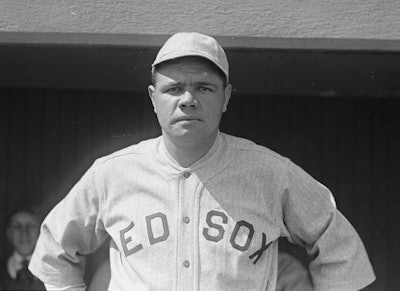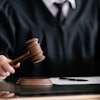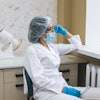
Many legends surround baseball great Babe Ruth, some of mythic proportions. In addition to his amazing feats on the diamond, he was also known for his (supposedly) prodigious consumption of food, tobacco, and alcohol, which many have long believed led to his demise of throat cancer at the age of 53.
Now New York dentist William Maloney wants to set the record straight.
|
What is nasopharyngeal carcinoma? Nasopharyngeal carcinoma (NPC) originates in the epithelium of the nasopharynx. This aggressive form of undifferentiated squamous cell carcinoma is the leading form of cancer in certain populations in China, Southeast Asia, the Arctic, North Africa, and the Middle East. More than 50,000 people worldwide die each year from NPC (CA: A Cancer Journal for Clinicians, March/April 2005, Vol. 55:2, pp. 74-108). The most common treatment is radiotherapy; however, because the disease is often not detected until it is quite advanced, the prognosis is a less than 50% survival rate within five years. Dentists can play a key role in recognizing the signs and symptoms of NPC, according to Ines Velez, D.D.S., director of oral and maxillofacial pathology in the department of oral diagnostic sciences at Nova Southeastern University College of Dental Medicine. "The dentist may discover a lesion in the area and refer the patient to an oral and maxillofacial surgeon or to an ear-nose-throat specialist," she said. "This is a very important step, to examine the oronasopharynx." Signs and symptoms of NPC include the following:
|
After a year of extensive research into Ruth's personal and medical histories, Dr. Maloney says that, contrary to the history books, Ruth did not die of throat cancer. Rather, he succumbed to nasopharyngeal carcinoma (NPC), a rare genetic cancer that is often misdiagnosed (see sidebar).
Dr. Maloney, a general dentist and assistant professor at the New York University College of Dentistry, is not the first to discover this little-known fact; in 1999, a group of doctors from the University of California, San Francisco published an article in the medical journal Laryngoscope (January 1999, Vol. 109:1, pp. 1-2) claiming that, based on reviews of Ruth's autopsies, he did not die of larynx cancer but of NPC. In particular, the autopsy clearly showed that Ruth's larynx was cancer-free.
But Dr. Maloney's research, published in the Journal of the American Dental Association (July 2008, Vol. 139:7, pp. 926-932), takes a more in-depth look at those earlier findings, putting them in the context of Ruth's diagnostic and treatment experiences and his eventual role in early cancer research.
"I set out to write a paper on the negatives of smoking and drinking as a cause of oral cancer, using Ruth as an example," he said. "Early on I was dismayed to find out that he didn't have oral cancer but NPC."
According to Dr. Maloney, during the summer of 1946, Ruth experienced intense left retro-orbital pain and was admitted to a hospital in September. The entire left side of his face was swollen and his left eye completely shut. The doctors misdiagnosed him initially with infected teeth and recommended he have several teeth extracted, which he did. They also thought he might have sinusitis and treated him with antibiotics. When these efforts yielded only minimal relief, Ruth subsequently underwent radiation therapy after the doctors assumed that, because of his history of heavy alcohol and tobacco consumption, he had laryngeal carcinoma.
Such misdiagnoses are common with NPC even today, Dr. Maloney said.
"This disease is very hard to diagnose," he said. "It is occurs in the back of the throat, on top of the pharynx, usually originating in the lateral wall of the nasopharynx. NPC doesn't really have any oral symptoms; the main symptoms are problems with one eye, loss of hearing in one ear, and nose bleeds. But, usually, when it gets to that stage, it's pretty far along."
Dr. Maloney believes that dentists can play an important role in diagnosing NPC and helping patients with NPC to better manage the effects of radiotherapy, the most common treatment for NPC.
"If a patient comes in complaining about ear problems or eye problems on one side or nose bleeds, they might think it has something to do with their teeth," he said. "But, if on examination, there isn't anything wrong in the oral cavity, they should be referred out to an ENT surgeon. If this disease is caught early enough, there is a very high success rate."
Unfortunately for Ruth, the misdiagnosis allowed the disease to continue to advance. He ultimately turned to an experimental treatment that was the precursor to what we now know as chemotherapy. Working with a New York oncologist, Richard Lewisohn, in 1947 he began daily injections of teropterin -- Ruth was the first human subject ever to undergo such treatment. According to a 1998 story in the New York Times, the treatment brought him some much-welcome relief and prolonged his life for a year, Dr. Maloney said.
It also gave him the opportunity to help others. ''I realized that if anything was learned about that type of treatment, whether good or bad, it would be of use in the future to the medical profession and maybe to a lot of people with my same trouble,'' he wrote in his autobiography (The Babe Ruth Story, E. P. Dutton & Co., 1948).
"I was struck by the fact that this great superstar was so willing to help future generations," Dr. Maloney said. "He has been so documented throughout history as a great ballplayer and celebrity, but this part of his life, which is so historically and medically significant, hasn't been documented well at all."















